Abstract
To avoid serious clogging and loss of drainage capacity, which puts the underground structure at risk of anti-floating failure, the buried drainage filter must be equipped with a nonwoven geotextile layer. In this scenario, nonwoven geotextiles are subjected to normal compressive stress, which can cause changes in geotextile porosity and structure, affecting the filtration behavior of the geotextile filter. In this paper, in order to evaluate the filtration compatibility of the soil–geotextile system, gradient ratio (GR) tests were performed under a hydraulic gradient of 1.0 using a specially designed gradient ratio filtration device capable of applying normal stress. In total four nonwoven geotextiles and two types of soil were used. The results of the gradient ratio filtration tests were discussed in terms of GR values, the permeability of the soil–geotextile system, and the amount of fines retained in geotextiles. It was shown that under a larger normal compressive stress, the GR value would also increase, while the permeability coefficient of the soil–geotextile system decreased. The filtration responses to various soil–geotextile combinations differed under normal compressive stress. A thick nonwoven geotextile with a small filtration opening size exhibited poor filtration performance while benefiting soil retention. Fines retention was influenced by geotextile thickness, soil type, and normal compressive stress magnitude. In addition, for nonwoven geotextiles filter fine-grained soil under normal compressive stress, the test results indicated that anticlogging design criteria should be improved.
1. Introduction
Geotextiles have been widely used as a substitute for the granular filter to provide filtration and drainage functions in underground structure drainage systems due to their ease of availability and convenient construction [1,2,3,4,5,6]. A geotextile filter should meet not only the soil retention and permeability criteria but also the anti-clogging criterion, because a filtration system may become clogged by fine particles trapped inside geotextile pores during its service life.
Geotextiles placed horizontally between the base soil and the gravel layer can perform the filtration function in filtration engineering. That is, it effectively prevents soil particles from undue migration or loss, as well as excessive seepage deformation or even soil destruction. Simultaneously, the water in the soil is allowed to discharge smoothly to avoid soil instability caused by the increase in pore pressure. Geotextiles can also perform the filtration function when wrapping the surface of a blind ditch filled with gravel to form an edge drainage system. In general, the gravel blind ditch covered by geotextile is difficult to be repaired or replaced during the service period of active anti-floating engineering of underground structures. As a result, the primary concern for a geotextile used as a filter layer is its long-term performance in terms of permeability and clogging prevention.
Early geotextile filter research primarily focused on the geotextile filtering granular soil [7,8,9,10,11]. The formation mechanism of the “self-filter layer” of geotextile filtering granular soil, also known as a natural filter layer, has been proposed based on experimental research and numerical simulation analysis [12,13]. The mechanism is as follows: while the geotextile performs its filtration function, fine particles close to the filter layer are allowed to pass through the geotextile, forming a thin layer of arch composed of coarse-grained soil forms on the surface of the geotextile, i.e., the natural filter layer. However, such a “self-filter layer” in fine-grained soil with particle size less than 0.075 mm barely exists due to the cohesive connection between soil aggregates during the filtration process. Stoltz et al. [14] investigated the filtration behavior of clayey sludge with nonwoven geotextiles and discovered that the working principle of geotextiles for filtering clayey sludge or fine particle suspensions was more complex than that for filtering granular soil suspension. In this case, the filtration mechanism of geotextile filtering granular soil may not be applicable to fine-grained soil.
At the present, the gradient ratio (GR) filtration test is mainly adopted for the evaluation of the filtration characteristics of geotextiles [6,9,15,16,17,18]. The gradient ratio filtration test calculates the hydraulic gradient of the corresponding area by measuring the water head difference between different positions of the sample under no stress action to determine the GR of the soil–geotextile system. GR value is the ratio of water head loss per unit seepage path of the soil–geotextile combination (25 mm thick soil layer plus geotextile thickness) to the water head loss per unit seepage path of the soil layer (50 mm thick). Calhoun also stated that GR values can be used to assess the filtration compatibility of the soil–geotextile interface. When GR = 1, the hydraulic head loss through the soil sample and filter is uniform. GR < 1 indicates that soil particles are passing through the geotextile forming piping, whereas GR > 1 indicates that there is potential clogging in the geotextile’s upstream or adjacent surface [19]. Therefore, the US Army Corps of Engineers [20] proposed that the GR of the soil–geotextile system should be less than 3 as the critical value for no clogging, as well as GR ≤ 3 was included in the filter criteria for geotextiles as a clogging resistance criterion. Since the existing geotextile filter criterion is proposed in absence of stress, it may be ineffective in evaluating the clogging potential of a soil–geotextile system under stress action. Furthermore, when using the existing gradient ratio permeameter, the effect of normal compressive stress cannot be considered. However, a geotextile used as a filter in underground structure drainage system applications is generally subjected to normal compressive stress, such as the geotextile filter beneath the basement of the underground structure. In addition, some studies in the literature show that an increase in normal stress has a significant impact on the filtration opening size and soil retention of geotextiles [21,22]. Given this, in this study, a gradient ratio permeameter equipped with a vertical loading device is developed to investigate the filtration performance of nonwoven-geotextile filtering fine-grained soil subjected to various normal stresses.
The objective of the current study is to evaluate the filtration compatibility of nonwoven geotextiles with fine-grained soils in underground structure active anti-floating systems by conducting a series of gradient ratio filtration tests under typical normal compressive stress conditions. The results of testing on various soil–geotextile combinations are presented and assessed. The key findings from the tests are presented and discussed in the following sections.
2. Test Materials
2.1. Geotextiles
Four different needle-punched nonwoven geotextiles from the same manufacturer with thicknesses ranging from 1.0 to 3.2 mm were selected in this study, named after GT1, GT2, GT3 and GT4. The need-punched nonwoven geotextiles were further classified by their thickness (tGT) as thin GT (tGT ≤ 1mm), medium thickness GT (1< tGT ≤ 2.5 mm) and thick GT (tGT > 2.5 mm). The nonwoven geotextiles selected here are commonly used as filters in applications such as blind drains, pavement edge drains and under revetments or dam riprap. Their physical and hydraulic properties are given in Table 1. The geotextile pore size was obtained using the dry sieving method. As shown in Figure 1, the filtration opening size (O95) for the geotextiles was determined from the pore size distribution curves in the 0.066~0.17 mm range.

Table 1.
Properties of selected nonwoven geotextiles.
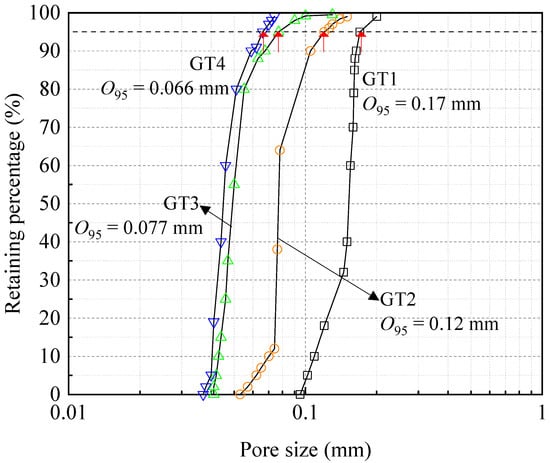
Figure 1.
Pore size distribution of the test geotextiles.
2.2. Soils
To simulate the actual work scenarios of the underground structure in the application of active anti-floating engineering, two kinds of natural soils were used for the gradient ratio filtration tests. The natural soils were classified as silty clay (C) and silt (M) according to BS EN ISO14688-2 [23]. The gradation curves and characteristic properties of natural soils are shown in Figure 2 and Table 2. In general, the tested silty clay was internally stable, while the tested silt was internally unstable according to the grain-size distribution method proposed by Kenney and Lau [24] (Figure 2 and Table 3).
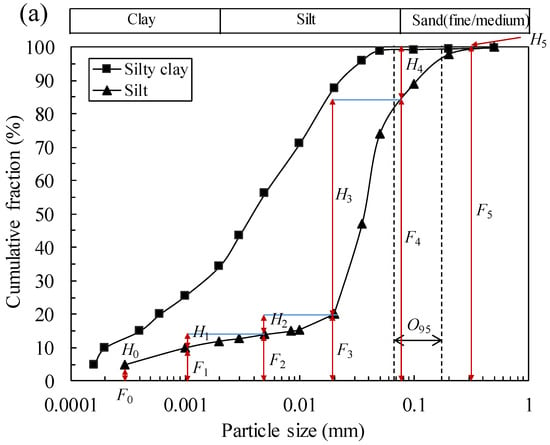
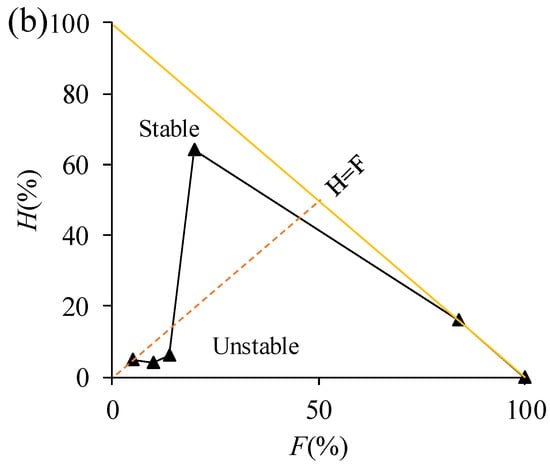
Figure 2.
Gradations of the natural soils: (a) particle size distribution curve of silty clay and silt, and coordinates for the construction of silt internal stability graphs according to Kenney and Lau (1985) [24]; (b) internal stability of silt graphs according to Kenney and Lau (1985) [24].

Table 2.
Descriptions of the natural soils.

Table 3.
Fn and Hn point coordinates.
3. Test Preparation
3.1. Specimen Preparation
Five circular nonwoven geotextile specimens with a diameter of 10 cm were cut from the original 0.6 m wide rolls of geotextile samples provided by the manufacturer. Before placing the geotextile specimens in the test device, they were weighed with an electronic balance with a precision of 0.001 g. The geotextile specimen was saturated with de-aired water for 24 h. Light taps on the geotextile specimen while immersed in de-aired water aided in the release of trapped air bubbles within the geotextile. De-aired water was used in all tests to prevent bubbles from adhering to the pores of the nonwoven geotextiles during the test, which could disrupt the passage of soil particles and cause “false clogging”.
The soil used in the experiment was natural soil after drying, crushing and screening to remove the particles with a size greater than 5 mm. For each test, 1190 g of soil sample was used, divided into 7 layers through a funnel into the permeameter after levelling.
3.2. Apparatus
The current study developed a new gradient ratio filtration test apparatus to evaluate the clogging potential of a fine-grained soil–geotextile system that could apply normal compressive stress to the soil layer through an overlying porous plate. A schematic diagram and an image of the experimental apparatus are presented in Figure 3 and Figure 4. It mainly consists of a pneumatic pressure device, a permeameter chamber and a water supply overflow system. The permeameter chamber is made up of two 100 mm internal diameter and 120 mm outer diameter acrylic cylinder sections, as well as a clamp specimen, mounted between two cylinder sections. A clamp made of two stainless steel flanges with an internal diameter of 100 mm is employed to secure the geotextile specimen. On the permeameter chamber’s sidewall, there are seven manometer ports. Each port is fitted with a screen to prevent fine particles from clogging it. In addition, manometer ports connected by glass tubes are used to monitor the water head distribution at different locations. Ports 3 and 5, as well as ports 4 and 6, are symmetrically distributed to ensure sample homogeneity and improve measurement accuracy. Ports 1 and 7 are each 25 mm beneath the geotextile and 25 mm above the top soil layer. Port 2 is 3 mm from the top surface of the geotextile, and the clogging potential of the geotextile could be determined by observing the water head change of the glass tubes 1 and 2.
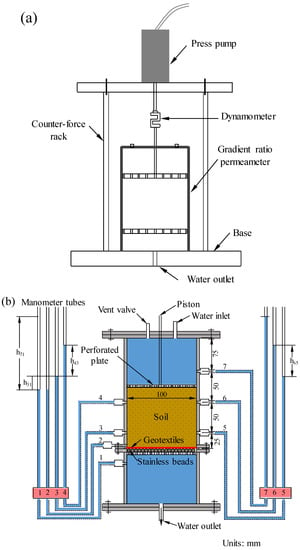
Figure 3.
Schematic of a new gradient ratio device for applying normal stress: (a) diagram of normal stress application; (b) details of gradient ratio permeameter.
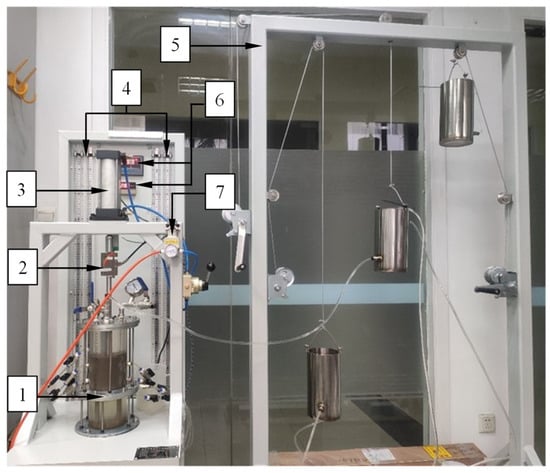
Figure 4.
Picture of the test apparatus (legend: 1—permeameter chamber, 2—dynamometer-LVDT, 3—a cylinder, 4—piezometers, 5—water supply overflow system, 6—stress and strain digital display instrument, and 7—pressure-regulating valve).
The pneumatic pressure device includes a cylinder, loading rod, air compressor, pressure-regulating valve and pressure gauge. The pressure-regulating valve is adjusted to simulate the normal compressive stress applied to the soil–geotextile system. The pressure sensor and the cylinder output end then display the stress in real-time. The linear variable differential transformer (LVDT) is mounted on the top cover of the permeameter chamber and is linked to the loading rod. The vertical displacement change of the soil–geotextile system is recorded when the applied normal compressive stress is stable. Upper and lower acrylic cylinders in the permeameter chamber allow the champed geotextile specimen to be inserted between a 100 mm soil layer and a layer of stainless steel beads. The steel beads, 16 mm in diameter, are placed above the perforated plate and beneath the geotextile specimen to simulate a drainage layer and to support the soil–geotextile system. The lower acrylic cylinder section, measuring 100 mm in height, is fixed on the base through the flange. The stainless steel beads and the perforated plate are housed in this section to support the test geotextile and drain seepage water. The upper acrylic cylinder section, 200 mm in height, contains the test soil as well as a perforated plate placed on top of the soil to distribute the applied normal compressive stresses. A top platen is attached to the top of the acrylic cylinder section, leaving holes for water inlets, a vent valve, and a loading piston that enters the permeameter chamber. The entire assembly is held together by six steel rods: the base, two acrylic cylinder sections, clamped geotextile, and the top platen. To seal off the water flow, O-rings are placed in the flange groove connecting the upper and lower acrylic cylinders, as well as between the upper acrylic cylinder and the top platen. To ensure that the opening area for water flow is the same for each test, the stainless steel beads are arranged in a specific pattern. Therefore, in this test series, the contact area between the geotextile and drainage layer will not be a variable for seepage flow [10].
4. Test Program
In the gradient ratio filtration test, vertical loads of 5 kPa, 10 kPa, 15 kPa and 25 kPa were used to simulate the normal compressive stress of the geotextile filter under the basement of the underground structure. A unidirectional flow condition through the soil and geotextile was maintained throughout the tests by using a constant differential head H (Figure 3b) with a hydraulic gradient of 1.0, which was a typical field condition if partial flow is permitted through the floor boundary [25]. The internally imposed hydraulic gradient across the samples was estimated to be 0.83~1.37, with lower hydraulic gradient values associated with system energy losses (e.g., pipe fittings) due to increased flow rate (soils with higher permeability). Such minor variations in the imposed hydraulic gradient are considered acceptable when evaluating the filtration performance of soil–geotextile combinations [26]. The test scheme is shown in Table 4. The loads applied in each group were 5 kPa, 10 kPa, 15 kPa and 25 kPa, with 0 kPa as the control group.

Table 4.
Gradient ratio filtration test scheme.
4.1. Test Procedures
The test setup assembly began with the lower acrylic cylinder being secured to the base. The lower acrylic cylinder was then fitted with an adjustable perforated plate. The stainless steel beads were placed on the perforated plate and adjusted to match the level of the test geotextile. The geotextile specimen was clamped and placed between two acrylic cylinder sections. The soil sample with 100 mm in thickness was placed layer by layer in the upper acrylic cylinder above the geotextile specimen. A scale was attached to the upper acrylic cylinder wall to measure the height of the soil sample. The density of the test soil was measured for each 15 mm thick increment of the soil layer using the volume mass control method. A perforated plate with a loading rod was placed on top of the soil layer, and the entire assembly was secured with six steel rods. After that, the loading rod was connected to the dynamometer in the pneumatic loading device, which was placed above the entire permeameter chamber setup. An LVDT was attached to the top of the permeameter chamber setup to measure the vertical displacement of the soil–geotextile system during a stress-flow stage. Before applying normal stresses, the ASTM D5101-12 [18] procedures for saturating the soil–geotextile system were followed.
By adjusting the pressure-regulating valve, normal compressive stresses of 5 kPa, 10 kPa, 15 kPa, and 25 kPa could be applied to the soil–geotextile system via a loading piston. After normal compressive stress became stable, de-aired water was allowed to flow through the soil–geotextile system with a hydraulic gradient of 1.0. The GR filtration test stabilized when the flow rate and gradient ratio for three consecutive tests were within 10% of their apparent value [27]. To avoid the artificial reading error, flow rates at various elapsed times (h) were measured using a digital balance. Following the completion of a filtration test, soil particles entrapped in the geotextile specimens were carefully collected, dried and weighed to evaluate the clogging degree of geotextile filters.
4.2. Test Parameters
The clogging behavior of a given soil–geotextile system can be assessed by its gradient ratio values [18]. To calculate the hydraulic gradients, relative measurements of differential water heads and seepage path lengths at different pressure ports are taken at the same time intervals. The behavior of the soil–geotextile composite (the combination of soil length 25 mm and geotextile specimen thickness), which was also assumed to be that of a geotextile filter, is characterized by the ratio:
where isg is the hydraulic gradient across the filter (the combination of 25 mm soil and geotextile thickness), and is is the reference hydraulic gradient in the soil measured in a region away from the geotextile filter (i.e., 50 mm soil layer). ∆hsg is the hydraulic head loss due to the geotextile filter, which is defined as the difference between the average hydraulic head values of No.3 and No.5 piezometers and the hydraulic head value of No.1 piezometers. ∆hs is the hydraulic head loss through the soil away from the filter layer, which is calculated by the average hydraulic values of the head difference between the No.3 and No.4 piezometers and those of No.5 and No.6 piezometers. lsg and ls are the seepage path corresponding to the hydraulic head loss, respectively.
As suggested by Sabiri et al. [3], Aydilek and Edil [28], and Abbaspour et al. [29], the permeability coefficient ratio kR was also preferred to define the clogging conditions, shown as:
Using the continuity of flow, the permeability of the soil ks between ports 3 and 4 is related to the permeability of the soil–geotextile composite ksg:
Thus, the gradient ratio can also be expressed:
The flow behavior of any given soil–geotextile system can be assessed using its flow curve, which depicts the hydraulic conductivity versus time. Darcy’s law is used to calculate the hydraulic conductivity k of the entire soil–geotextile system, as shown in Equation (5):
where Q is the seepage flow quantity passing through the filter during time t (m3), A is the section area of the drainage surface (A = 7.85 × 10−5 m2) and ∆h is the total hydraulic head loss through the whole specimen (m). l is the height of the soil sample causing the hydraulic head loss, which is 100 mm. t is the seepage time (t = 3600 s).
The mass of fine particles retained inside geotextile fibers after the filtration tests for any given system was measured as the weight of fine particles per unit (retained) area (g/m2), which was calculated in a formula (6). For each system tested, the amount of fine particles retained inside the geotextile fibers is given in Table 5.
where η is the mass of entrapped soil particles inside geotextiles (g/m2), m0, m1 are the mass of geotextiles before and after the test (g).

Table 5.
Mass of fine particles retained inside the geotextile fibers after the entire filtration test at 48 h.
4.3. Repeatability of the Tests
Due to the variability in properties of the materials (mainly geotextiles) and the nature of the GR test, a 10% uncertainty range in GR values is expected in carefully conducted tests [30]. To check the repeatability of the experiment, duplicate GR tests were conducted using GT1 (thin GT) and GT4 (thick GT). Table 6 shows typical test results, demonstrating that the test results are generally repeatable and in good agreement. Moreover, the variation within the GR values is within 10%.

Table 6.
Gradient ratio filtration test results of silty clay (i = 1.0).
5. Test Results
5.1. Filtration Behavior of Silty Clay
Twenty filtration tests were performed using silty clay (internally stable soil) in combination with four different geotextiles (GT1–GT4) to assess their filtration behavior under normal stresses.
Figure 5 depicts the GR and the permeability coefficient values for the silty clay–geotextile combinations. As a reference, the filtration test results for the same soil–geotextile combination free of normal stress were used. As shown in Figure 5, the GR values decreased slowly with the elapsed time but increased with the increase of normal stress, and the coefficient of permeability decreased with the elapsed time and the increase of normal stress. These findings suggested that the filtration performance of soil–geotextile combinations was significantly affected by normal stress. Additionally, a little variation of GR was observed after an elapsed time of 48 h at each system, indicating a steady state flow condition.
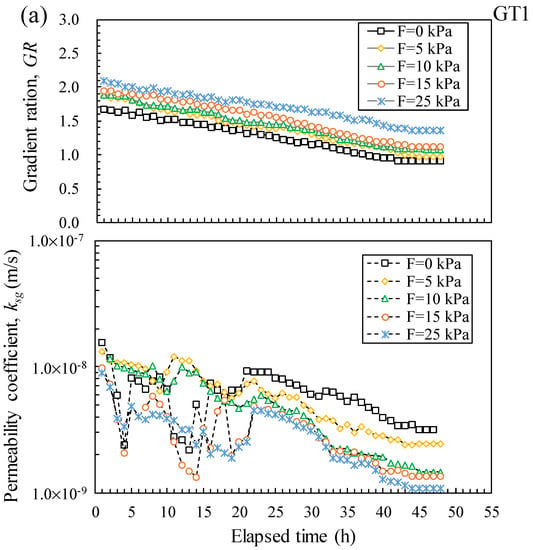
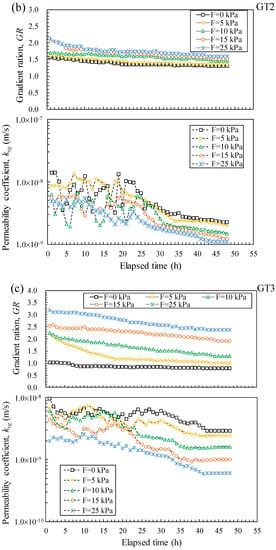
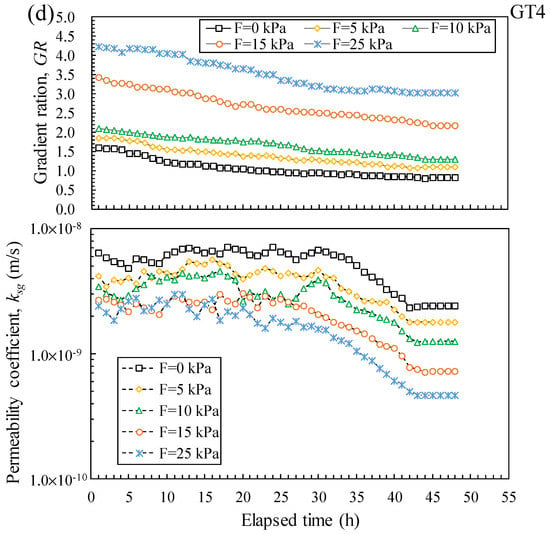
Figure 5.
Filtration test results for silty clay with four geotextiles: (a) C-GT1 combination; (b) C-GT2 combination; (c) C-GT3 combination; (d) C-GT4 combination.
The permeability coefficient ksg of geotextile samples with silty clay exhibited some fluctuation during the initial 25 h. Following that, the ksg values tended to decrease as normal stress increased. There were no significant differences in ksg between the geotextiles in GT1 and GT2. When the applied normal stress exceeded 10 kPa, the differences in permeability coefficient ksg for thick geotextiles (GT3 or GT4) were more pronounced than for thin geotextiles, i.e., the ksg of thick geotextiles decreased from ksg × 10−9 m/s to ksg × 10−10 m/s, while thin geotextiles changed in the order of ksg × 10−9 m/s. The ks values were marginally higher than ksg values for the most of silty clay–geotextile combinations (Table 7), indicating the migration of fines from the soil towards the geotextiles where clogging or blinding may occur. Therefore, a decrease in ksg values of the soil–geotextile composite under larger normal stress could result in an increase in GR values.

Table 7.
Summary of the gradient ratio test results at 48 h performed on the silty clay–geotextile combination.
Table 7 summarizes the results of the filtration test for combinations composed of each geotextile and the silty clay under five different magnitudes of normal stress. As shown in Table 7, an increase in GR values was noticed as the normal stress increased from 0 kPa to 25 kPa. For the test cases using thin and medium thick geotextiles (GT1, GT2), the increment in GR values increased around 28% and 22%. For the thicker geotextiles (GT3 or GT4), however, the GR values increased significantly with normal stress, increasing by about 198% and 269%, respectively, particularly when the normal stress was greater than 10 kPa. It is generally acknowledged that the specific surface area (Sa) of the nonwoven geotextile responds significantly to fine particles retained on the surface of the geotextile filter. The greater the Sa is, the more prone the geotextile filter is to be deposited or adsorbed by fine particles. Furthermore, the curved and continuous pores in the nonwoven geotextile form its filtration channel, and thickness is an important structural parameter influencing the size of the geotextile filtration channel. The greater the thickness is, the smaller the geotextile filtration channel is, resulting in more fine particles retained and larger GR values [31,32].
5.2. Filtration Behavior of Silt
Twenty filtration tests were performed using silt (internally unstable soil) in combination with four different geotextiles (GT1-GT4) to assess their filtration behavior under normal stresses, and the variation of fine particles retained inside the geotextile fibers was measured after the tests as shown in Table 5. Table 8 summarizes the results of filtration tests performed on combinations of each geotextile and silt under five different magnitudes of normal stress.

Table 8.
Summary of the gradient ratio test results at 48 h performed on the silt–geotextile combination.
Figure 6 shows the trends in the GR and ksg values of the silt with geotextile samples GT1, GT2, GT3 and GT4 over time under various normal stresses. As can be seen that the variation trend of GR and ksg values with normal stress was similar to that of the silty clay–geotextile system. The GR value ranged from 1.0 to 2.5 for all filtration tests in silt–geotextile combinations. A larger GR value was noticed in test cases using geotextile with larger thicknesses. This was due to the fact that thickness affected tortuosity, which reflected the path or distance travelled by a fine particle in the pore channel across the fabric. Thus, over filtration time, fine particles were more likely to become entrapped in the thick geotextiles. Additionally, the GR value of the M-GT4 combination was greater than that M-GT1 combination. This probably explained why GT4 retained more fines at the end of the filtration test than GT1 (Table 5). The permeability coefficient values for the silt with all geotextile samples decreased by one order of magnitude at a normal stress of 25 kPa. This could be attributed to the internal instability of silt, which induced the obvious migration of fine particles under the action of the flow drag force. The filtration channel in the geotextile filter could thus capture those moving fine particles, resulting in the erosion of fines near the geotextile interface and clogging of the geotextile, accompanied by a significant decrease in the permeability of the silt–geotextile combinations. Moreover, it was discovered that the ks values were greater than ksg for all silt–geotextile combinations (Table 8), resulting in a GR greater than 1.0, even though the GR values are still less than the clogging limit of 3 set by the U.S. Army Corps of Engineers [20], indicating that excessive clogging did not occur.

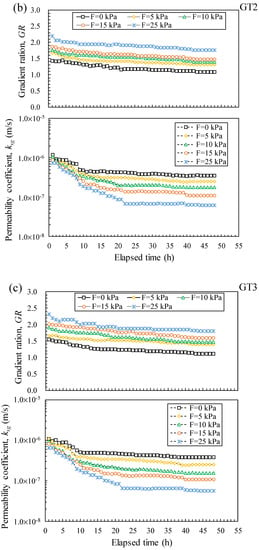
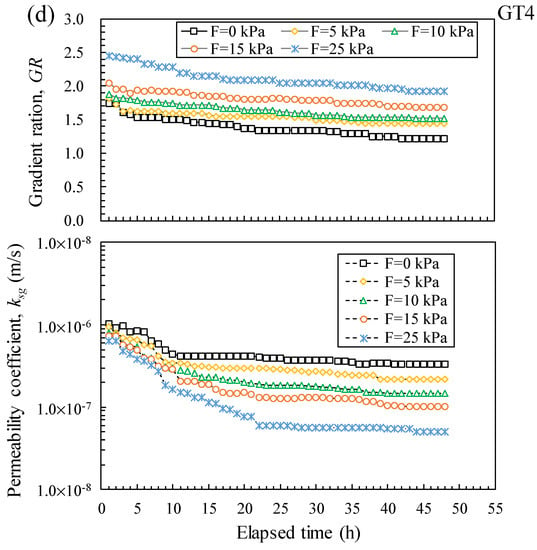
Figure 6.
Filtration test results for silt with four geotextiles: (a) M-GT1 combination; (b) M-GT2 combination; (c) M-GT3 combination; (d) M-GT4 combination.
In the following discussions, typical results of test cases using medium and thick geotextiles (GT2, GT4) will be selected to further investigate the influence of fabric structure and protected soil characteristics on the filtration performance of geotextile filters under different normal stresses.
5.3. Displacement and Soil Retention
Normal compressive stress can cause a thickness reduction in the soil layer and downward displacement in the clamped geotextile specimen, resulting in a denser state of the tested specimen. To evaluate the compression of the soil layer under normal stress, the soil–geotextile combination settlement and geotextile downward displacement should be measured simultaneously. Before the pre-test, the geotextile downward displacement corresponding to different normal stresses was calibrated separately by ASTM D5199-12 [33]. The new gradient ratio filtration test apparatus can measure the soil–geotextile combination settlement by protruding the probe of an LVDT through the porous plate.
Figure 7 illustrates the downward displacement of geotextiles and the soil layer settlement of soil–geotextile combinations (C/M-GT) under various normal stress conditions. It was found that the soil layer settlement increased continuously with the increase of normal stress, while geotextile downward displacement increased initially and then decreased when the applied normal stress exceeded 10 kPa. This was possibly due to the partial clogging of the geotextile, which reduced its compressibility. In addition, the normal stress applied on the top of a 100 mm thick layer was unable to be fully transmitted to the geotextile [34]. Thus, soil layer settlement showed a sensible significant response to normal stress when compared to geotextile displacement. Furthermore, soil layer settlement or geotextile displacement was slightly greater in the soil-GT4 combinations (C/M-GT4) than in the soil-GT2 combinations (C/M-GT2). This was attributed to the thickness of tested geotextiles as well as soil type. Hence, a certain normal stress could cause in-plane compression on the clamped geotextile specimen, and the compression was affected by the initial thickness and fine particle retention of the geotextile.
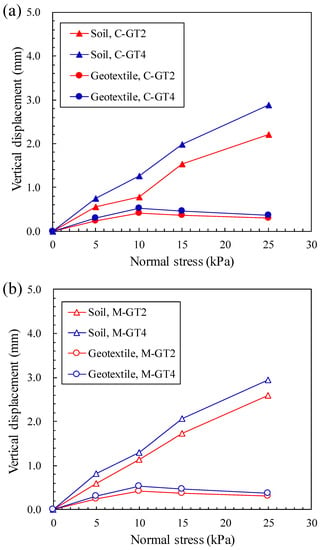
Figure 7.
Downward displacements for soil–geotextile combinations subjected to normal stresses: (a) C-GT2/GT4 combinations; (b) M-GT2/GT4 combinations.
The fine particles retained (η) of the four soil–geotextile combinations at different normal stresses are shown in Figure 8. The η values were closely related to the soil type and geotextile thickness. The fine particles retained (η) of the four soil–geotextile combinations increased with an increase in normal stress. When the normal stress was 0 kPa, the η values of C-GT2, M-GT2, C-GT4, and M-GT4 were 271 g/m2, 465 g/m2, 605 g/m2, and 610 g/m2, respectively. When the normal stress was increased to 25 kPa, the η values of C-GT2, M-GT2, C-GT4, and M-GT4 increased by 96%, 53.8%, 39.8%, and 53.9%, compared with those free of normal stress. This was mainly because, when the normal stress increased, soil layer settlement increased, and the structure of fibers became denser, resulting in an increase in the η values. Comparing the results from GT2 and GT4 combinations, it was observed that for geotextile with larger thickness, more fine particles tended to be gathered. The mass of fine particles retained from filtered silt (internal instability) was clearly greater than that of silty clay in terms of geotextile combinations. These observations were consistent with the above results, i.e., the thicker geotextile had a larger GR and the ksg of silt–geotextile combinations decreased significantly, especially at a normal stress of 25 kPa.
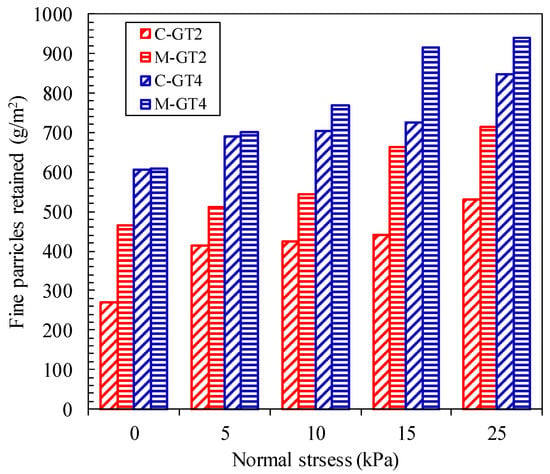
Figure 8.
Relationship between fine particles retained and normal stress acting on soil–geotextile combinations.
6. Discussion
6.1. Influence of the Natural Soils Internal Stability on Retention Capability
The prediction of nonwoven geotextile filtration opening size proposed by Giroud [35] was used to evaluate the variation of filtration opening size of geotextile under different normal stresses:
where Of is the geotextile filtration opening size O95, df is the fiber diameter, n is the geotextile porosity, is the geotextiles thickness under different normal stresses according to EN ISO 9863-1 [36], and ξ is the empirical parameter, ξ = 10.
The retention ratio, Rr = O95/Dn, is commonly used to assess the retention capability of a given soil–geotextile system. Dn is the particle size of the tested soil, and D85 or D50 are the most commonly used representative particle sizes. The existing fine-grained soil retention criteria provide the upper limit of soil retention for nonwoven geotextile, i.e., O95/D85 ≤ 2~3, or O95/D50 ≤ 18/Cu [37,38,39,40].
Figure 9 shows a plot of fine particles retained η against O95/Dn for tests on two natural soils and geotextiles based on the above theoretical calculation of nonwoven geotextile filtration opening size. The relationship between η and O95/Dn illustrates that Rr controls the onset of piping or erosion. The amount of fine particles retained was very sensitive to increases in the retention ratio. The results, although not as comprehensive as desired, showed no significant consistency with the existing soil retention criterion for an O95/D85 less than about 3.6, or an O95/D50 less than about 16.3. They did support a relationship between filtration opening size and fine-grained soil particle size for soil retention. As the Rr with a small variation range, the characteristic particle size D85 was a more sensitive indicator of retention for silty clay than D50, while D85 or D50 was a more sensitive indicator of retention for silt than D15. Furthermore, the retention ratios of silt were found to be significantly smaller than those of silty clay. Although the silt soil–geotextile combination showed a larger amount of fine particles retained inside geotextiles (Figure 9b). This indicated that internally unstable silt allowed fines to move freely through the coarse particles, resulting in a greater amount of fine particles retained.
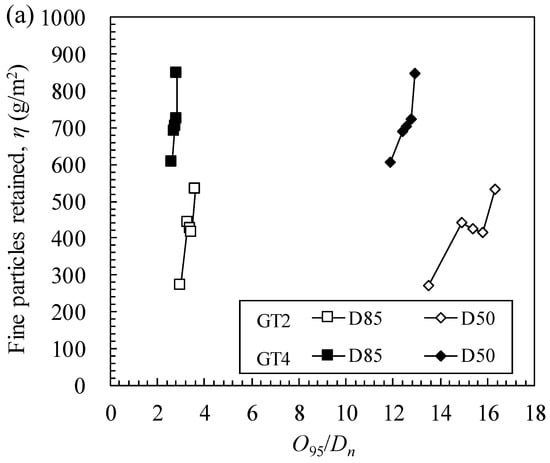
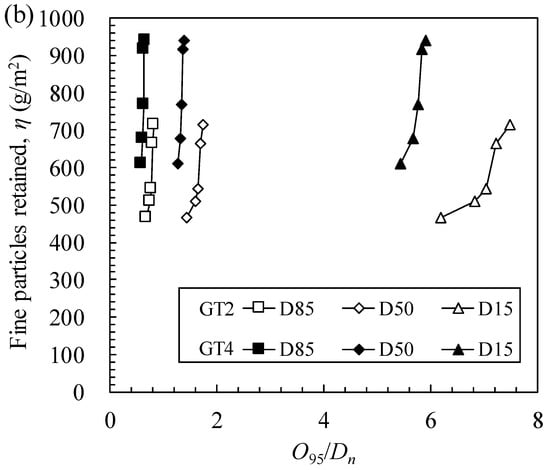
Figure 9.
The amount of fine particles retained in the η and O95/Dn ratios: (a) C-GT2/GT4 combinations; (b) M-GT2/GT4 combinations.
A GR value greater than one was obtained for both tested soils with nonwoven geotextiles (GT2, GT4) during different normal stress stages, indicating that the soil–geotextile interface was less permeable than the base soil, i.e., ksg < ks (Table 7 and Table 8). Although the retention ratios of GT4 were lower than those of GT2, GT4 retained more fine particles than GT2. This was due to the fact that GT4 had a smaller filtration opening size O95 and a larger thickness tGT than GT2. Moreover, this difference in response could be attributed to the thicker GT4, which trapped fines inside the smallest constrictions in the geotextile and subsequently hampered the movement of migrating particles within the fabric.
6.2. Influence of the Normal Compressive Stresses on Filtration Performance
6.2.1. Normalized Parameters
The following normalized parameters are introduced to effectively compare the data from experiments conducted on two natural soils and geotextiles characterized by different normal stresses: relative pore volume (RPV) and relative permeability coefficient (Krel). The relative pore volume (RPV) is defined as the flow volume divided by the initial soil pore volume, i.e.,
where q is the system flow rate (cm3/h), ne is the initial soil porosity and V is the initial soil volume (cm3).
The relative permeability coefficient Krel is defined as follows:
where K is the absolute system (i.e., soil–geotextile system) permeability coefficient at any given time during the test and Kini is the initial system permeability coefficient.
Note that when the permeability coefficient of the system decreases by one order of magnitude, Krel = 0.1. Blinding occurs when fine particles migrating from a distance are retained and accumulated near the geotextile interface. The hydraulic conductivity increases locally in the zone from which the fine particles originated but decreases in the interface zone with the geotextile as the porosity in the interface area decreases and the flow channel fills. As a result, the system permeability decreases without reaching a satisfying equilibrium, and the Krel ≤ 0.1. On the contrary, internal blockage occurs with Krel > 0.1, when the migrated fine particles penetrate the filter fabric and encounter fiber constrictions too narrow to move further, and the fine particles then accumulate within the geotextile and obstruct the drainage channels. Therefore, the following analysis uses Krel = 0.1 as the critical value for distinguishing between blinding and clogging.
6.2.2. Gradient Ratio and Relative Permeability Coefficient
Figure 10 presents the relationship between Krel or GR and relative pore volume (RPV) for two natural soils filtered by GT2 and GT4. As shown in Figure 10, the relative permeability coefficient (Krel) decreased with the decrease of the relative pore volume (RPV) and presented a linear change, indicating that the Krel constantly decreased over time. The relative pore volume (RPV) decreased while the GR increased as the normal stress increased, and the effect of relative pore volume on the GR was insignificant.
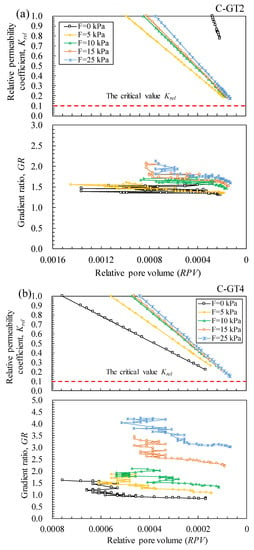
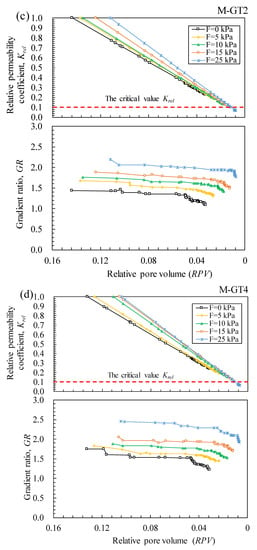
Figure 10.
The Krel and GR versus relative pore volume (RPV) for two natural soils filtered by GT2 and GT4: (a) C-GT2 combination; (b) C-GT4 combination; (c) M-GT2 combination; (d) M-GT4 combination.
When the protected soil was silty clay as shown in Figure 10a,b, the relative permeability coefficient was Krel > 0.1 and the change of relative pore volume was small within 0.0016. This indicated that the clogging occurred when migrating fine particles penetrated the filter fabric and encountered fiber constrictions that were too narrow for them to travel further. Fines could then accumulate within the geotextile and obstruct its drainage channels. This was also the reason why ksg < ks, i.e., the head loss through the geotextile filter was greater than the base soil of the adjacent layer (Table 7). When the normal stress was 25 kPa, the GR changed dramatically, with the medium thickness GT2 reaching 1.60 and the thick GT4 exceeding the critical value of 3.0. This indicated that the high-stress level had a pronounced influence on GR for the natural soil–geotextile system.
When the protected soil was silt as shown in Figure 10c,d, the relative permeability coefficient Krel < 0.1 appeared as the normal stress was 25 kPa under the combination of M-GT2/GT4, indicating the occurrence of blinding. The change in relative pore volume was within 0.16, which was two orders of magnitude greater than the above silty clay–geotextile combination. This was because the protected silt was more permeable than silty clay (Table 2). The GR varied similarly to silty clay, i.e., the high-stress level had a significant influence on the GR, but the GR was less than the critical value of 3.0. This was most likely due to the protected silt’s higher permeability and internal instability, which caused blinding and local clogging in the geotextile filter. This phenomenon would be explained further in subsequent discussions (Table 9).

Table 9.
Summary of the operational data and gradient ratio filtration test results at 48 h.
Table 9 summarizes the key findings from two typical tests performed under normal stress conditions of 0 kPa and 25 kPa. The average flow rate values are useful indicators of the filter system’s hydraulic performance. The higher these values, the better the filter system. As shown in Table 9, the measured values of the average flow rate varied greatly from 0 kPa to 25 kPa. In particular, with the M-GT2/GT4 combinations, the average flow rate decreased by approximately 58%. Clogging was the most common filtration result observed in the tests conducted, except for the combination of silt and geotextile under high normal stress conditions. This was due to the fact that when higher normal stress was applied to the soil–geotextile combination, the geotextile produced plane compression and the structure became dense, resulting in a decrease in the average flow rate. The internal instability of the protected silt caused more fine particles migrating from a distance to be retained and accumulated in the interface zone near the geotextile, resulting in blinding, i.e., M-GT2/GT4 combinations. The seepage channel was filled with fine particles as a result of the decrease in porosity in the interface zone near the geotextile, resulting in a local increase in permeability in the zone from where the fine particles originated, but the permeability in the interface zone near the geotextile decreased. As a result, the average flow rate of the M-GT2/GT4 combinations dropped significantly.
6.2.3. Gradient Ratio and Geotextile Head Loss
Figure 11 depicts the gradient ratio (GR) and geotextile head loss (GHL) versus relative pore volume data obtained from the tests described in the previous section. GHL represents the change in water level difference between manometer tubes 2 and 3 over time. As shown in Figure 11, the GR and GHL showed the same trend with the relative pore volume. This was because the GR represented an indicator of the erodibility of the fines in the soil matrix, and GHL was a measure of the clogging state of the geotextile openings. Under free normal stress, the higher the GHL, the finer particles were transported from the soil into the geotextile, and the higher the GR of the geotextile filter. A significant increase in GR and GHL was observed for both of these two natural soil types with normal stress, particularly when normal stress of 25 kPa was applied in combination with the thick geotextile, indicating more fine particles migration occurred over the duration of the test.
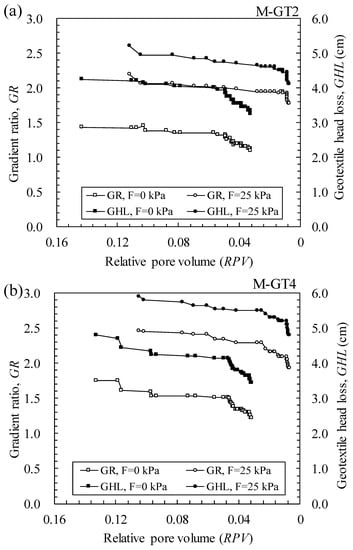
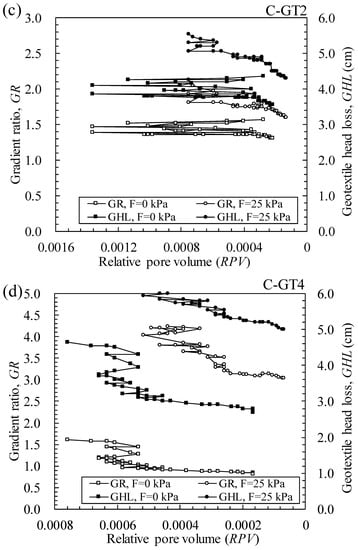
Figure 11.
The GR and GHL versus relative pore volume (RPV) for two natural soils filtered by GT2 and GT4: (a) M-GT2 combination; (b) M-GT4 combination; (c) C-GT2 combination; (d) C-GT4 combination.
Figure 11a,b shows that the GR and GHL are significantly higher when the M-GT2/GT4 combination is subjected to “blinding + clogging” (Table 9) under normal stress of 25 kPa than when subjected to 0 kPa action. For the combination of M-GT2, GR and GHL increased by 63% and 26%, respectively. The M-GT4 combination, GR and GHL increased by 58% and 39%, respectively. This was because, under normal stress, the planar compression of GT4 was greater than that of GT2 (Figure 7), and the filtration opening size of GT4 was smaller than that of GT2 (Figure 9), reducing the movement of fine particles and causing them to retain or accumulate on the soil–geotextile interface, resulting in blinding (Table 9). As a result, the head loss of GT4 was approximately 13% greater than that of GT2. As shown in Figure 11c,d, the GR of the normal stress of 25 kPa acting on the C-GT4 is significantly higher than that of the M-GT4 combination. This was because when the protected soil is silty clay (C), the single grain was small but had a certain adhesiveness and hydrophilicity and often appeared as an aggregate particle. Even if the particle size of the soil is smaller than the filtration opening size, it will also bond the geotextile fibers during the seepage filtration process, resulting in a decrease in the effective pore (channel) of the geotextile and clogging of the filter layer. Therefore, the normal compressive stress, protected soil types, and geotextile characteristics are the factors affecting the occurrence of clogging or blinding in the filtration system, with the stress level having a significant impact.
6.3. Implications for Design Practice
Regardless of the geotextile filter chosen for drainage applications, it must meet two competing requirements (i.e., retention and permeability) to ensure optimum performance. Soil retention necessitates a pore structure fine enough to retain erodible soils while avoiding clogging in the geotextile filter. The permeability requires the geotextile filter to maintain adequate permeability so that seepage from the protected soil is prevented.
According to the results of gradient ratio filtration tests, nonwoven geotextiles are more prone to clogging when filtering fine-grained soil, although they do not meet the requirements of soil retention ratio (O95/d85, O95/d50) in the existing filtration criteria [15,19,38,41]. This was because most fine particles would inevitably be trapped on the upstream surface and within the geotextile during the process of migration with water flow, resulting in a decrease in geotextile permeability and an increase in soil retention. The degree of geotextile clogging increased with continuous filtration until it reached a stable state. Therefore, for this protected soil, whether the clogged geotextile filter can meet the requirements, i.e., the value determination standard of GR and ksg, is a challenge for filter design.
The hydraulic gradient through the soil and soil–geotextile composite is determined by the type of soil and any interactions it has with the geotextile. Using the above typical experiment data with the silty clay and thicker geotextile combinations, Figure 12 schematically illustrates the relationship between water head distribution and gradient ratio without taking blinding into account. Based on the interrelationship between gradient ratio and relative permeability as shown in Equation (4), three zones are defined in Figure 12. The first boundary selects the water head distribution of the GT4 combination at different positions above the geotextile at 0 kPa. The first zone is defined as GR less than one and the permeability of the soil–geotextile composite exceeds that of the soil. The second boundary selects the water head distribution of the GT3 combination at different positions above the geotextile at 5 kPa. The second zone is a distribution in which the GR is greater than one but less than 3.0, and the permeability of the soil–geotextile composite is (0.35~0.98) times that of the soil, with a small value when the normal stress is high. The third boundary selects the water head distribution of the GT4 combination at different positions above the geotextile at 25 kPa. The third zone is defined as GR > 3.0, and the criterion of GR ≤ 3.0 is proposed for the clogging resistance.
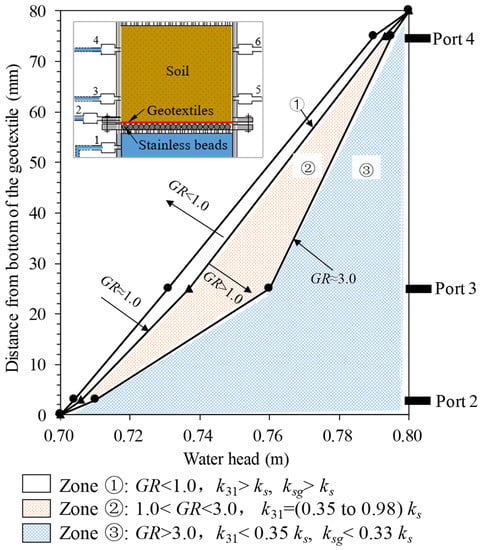
Figure 12.
A schematic interpretation of the gradient ratio filtration test results.
It is generally recommended that the permeability of the soil–geotextile composite increases along the flow direction (i.e., ksg > ks) to avoid unacceptable energy losses in filter design. Figure 12 shows that the water head distribution of zone 1 satisfied this condition, while zones 2 and 3 did not. The water head distribution in zones 1 and 2, however, was acceptable according to the relative hydraulic gradient defined by GR < 3.0. Note that the permeability ksg of a thick 25 mm soil and geotextile composite layer is k31. A significant inconsistency occurred in zone 2, i.e., the k31 could be less than 35% of the soil. The design criterion for a graded granular medium ensures the filter is approximately 20 times more permeable than the protected soils when the flow is perpendicular to the filter and into a permeable layer that meets the discharge requirements [42]. Since the geotextile filter criterion evolved from the graded sand filter criterion, similarly, the criterion for geotextile filters can be expressed as:
where λ is a factor governed by the water head loss that occurs across the soil–geotextile composite during seepage flow and the normal stress imposed on the soil–geotextile system.
It should be noted that clogging resistance is a prerequisite for its permeability. Since ksg describes the permeability of the soil–geotextile composite in service, its value is highly related to the site and soil specific. The anticlogging criterion uses a gradient ratio GR ≤ 3.0 to determine unclogging, so λ > 0.3. The gradient ratio filtration test with C-GT4 combination under the normal stress of 25 kPa described above revealed that was λ ≥ 0.4 (Table 7), no clogging occurred, and the gradient ratio was GR ≤ 2.5. Thus, the current anticlogging criterion was relatively conservative. In design using nonwoven geotextiles, it appears reasonable to accept a value of Kg less than ks, as shown in zone 2 of Figure 12, if no unacceptable impediment to seepage flow is produced. Therefore, it is required to formulate the anticlogging criterion of fine-grained soil in combination with the engineering application environment for the permeability of geotextile filters can meet the actual drainage requirements.
7. Conclusions
In this paper, a gradient ratio filtration test device capable of applying normal stress was designed and applied to perform a series of filtration tests on various nonwoven geotextiles and fine-grained soil combinations. The head loss through soil geotextile samples, as well as the variation with applied normal stress and time, were investigated to assess the compatibility of fine-grained soils and nonwoven geotextiles in filtration applications. Based on the gradient ratio filtration test results, the following conclusions can be drawn:
- Nonwoven geotextile filters with different filtration opening sizes, porosities, and thicknesses showed different compatibilities with fine-grained soil samples. Thick needle-punched nonwoven geotextile had a relatively smaller filtration opening size, and the permeability of the soil–geotextile system decreased by 1~2 orders of magnitude after 48 h of filtration, resulting in poor filtration performance.
- The filtration performance of geotextile filters responded significantly to applied normal compressive stresses. As normal compressive stress increased, GR values also increased but the permeability decreased in soil–geotextile combinations.
- Filtering fine-grained soils by needle-punched nonwoven geotextiles was primarily manifested as clogging, in which most of the fine particles were entrapped inside geotextile pores and retained on the fibers. The mass of fine particles per unit area was found to be significantly related to normal stress magnitude, soil characteristics, and nonwoven geotextile thickness, i.e., fine particle retention was greater when a thicker geotextile filters the internally unstable soil under higher normal compressive stress.
- Although the nonwoven geotextile clogged in fine-grained soil filtration, the soil–geotextile composite layer was relatively thin, and the head loss occurring across the composite layer would have little effect on the overall system’s seepage flow. Therefore, the lower permeability of soil–geotextile composites than protected soil was acceptable. Furthermore, the anticlogging of geotextile filters should be built into the permeability requirements. The current clogging criterion for nonwoven geotextiles filtering fine-grained soils is relatively conservative.
Author Contributions
Conceptualization, C.D., C.X. and Y.Y.; methodology, C.D., C.X., Y.Y. and J.W.; investigation, C.D.; writing—original draft preparation, C.D.; writing—reviewing and editing, C.D., C.X. and Y.Y.; supervision, C.X. and Y.Y.; project administration, C.X.; and funding acquisition, C.X. All authors have read and agreed to the published version of the manuscript.
Funding
This research was funded by the National Natural Science Foundation of China (grant number 42172297).
Institutional Review Board Statement
Not applicable.
Informed Consent Statement
Not applicable.
Data Availability Statement
Not applicable.
Acknowledgments
The authors greatly appreciate the comments from the reviewers, whose comments helped to improve the quality of the paper.
Conflicts of Interest
The authors declare no potential conflict of interest.
References
- Artières, O.; Tcherniavsky, J.G. Geotextile filtration systems for dams—30 years of improvement. In Proceedings of the 7th International Conference on Geosynthetics (ICG), Lisse, The Netherlands, 1 January 2002; Delmas, G., Girard, H., Eds.; Swets & Zeitlinger: Leiden, The Netherlands; pp. 969–974. [Google Scholar]
- Koerner, R.M. Early background and history of geotextiles. In Geotextiles; Elsevier: Amsterdam, The Netherlands, 2016; pp. 3–15. [Google Scholar]
- Sabiri, N.E.; Caylet, A.; Montillet, A.; Le Coq, L.; Durkheim, Y. Performance of nonwoven geotextiles on soil drainage and filtration. Eur. J. Environ. Civ. Eng. 2020, 24, 670–688. [Google Scholar] [CrossRef]
- Kim, K.H.; Park, N.H.; Kim, H.J.; Shin, J.H. Modelling of hydraulic deterioration of geotextile filter in tunnel drainage system. Geotext. Geomembr. 2020, 48, 210–219. [Google Scholar] [CrossRef]
- Guo, C.Y.; Wu, J.W.; Zhu, Y.; Lin, Z.B.; He, S.; Qian, Y.Z.; Yang, H.; Li, H.; Mao, W. Influence of clogging substances on pore characteristics and permeability of geotextile envelopes of subsurface drainage pipes in arid areas. Geotext. Geomembr. 2020, 48, 735–746. [Google Scholar] [CrossRef]
- Veylon, G.; Stoltz, G.; Meriaux, P.; Faure, Y.H.; Touze-Foltz, N. Performance of geotextile filters after 18 years’ service in drainage trenches. Geotext. Geomembr. 2016, 44, 515–533. [Google Scholar] [CrossRef]
- Koerner, R.M.; Koerner, G.R. Lessons learned from geotextile filter failures under challenging field conditions. Geotext. Geomembr. 2015, 43, 272–281. [Google Scholar] [CrossRef]
- Li, F.Q.; Wang, Z.; Chen, L.; Hu, Y. Research on hydraulic characteristics of partially clogged nonwoven geotextiles under pressure. Rock Soil Mech. 2008, 29, 3128–3132. (In Chinese) [Google Scholar]
- Palmeria, E.M.; Gardoni, M.G.; da Luz, D.W.B. Soil-geotextile filter interaction under high stress levels in the gradient ratio test. Geosynth. Int. 2005, 12, 162–175. [Google Scholar] [CrossRef]
- Wu, C.S.; Hong, Y.S.; Yan, Y.W.; Chang, B.S. Soil-nonwoven geotextile filtration behavior under contact with drainage materials. Geotext. Geomembr. 2006, 24, 1–10. [Google Scholar] [CrossRef]
- Kamruzzaman, A.H.M.; Haque, A.; Bouazza, A. Filtration behavior of granular soils under cyclic load. Geotechnique 2008, 58, 517–522. [Google Scholar] [CrossRef]
- Lafleur, J.; Mlynarek, J.; Rollin, A.L. Filtration of broadly graded cohesionless soils. J. Geotech. Eng. 1989, 115, 1747–1768. [Google Scholar] [CrossRef]
- Gourc, J.P. Training Course: Geosynthetics in Drainage and Filtration. In Proceedings of the 4th Asian Regional Conference on Geosynthetics, Shanghai, China, 17–20 June 2008. [Google Scholar]
- Stoltz, G.; Delmas, P.; Barral, C. Comparison of the behavior of various geotextiles used in the filtration of clayey sludge: An experimental study. Geotext. Geomembr. 2019, 47, 230–242. [Google Scholar] [CrossRef]
- Fannin, R.J.; Vaid, Y.P.; Shi, Y.C. Filtration behavior of nonwoven geotextiles. Can. Geotech. J. 1994, 31, 555–563. [Google Scholar] [CrossRef]
- Shan, H.Y.; Wang, W.L.; Chou, T.C. Effect of boundary conditions on the hydraulic behavior of geotextile filtration system. Geotext. Geomembr. 2001, 19, 509–527. [Google Scholar] [CrossRef]
- Cazzuffi, D.; Moraci, N. Design of geotextile filters in contact with granular soils. In Keynote lecture. In Proceedings of the 4th Asian Regional Conference on Geosynthetics, Shanghai, China, 17–20 June 2008; pp. 142–163. [Google Scholar]
- ASTM D5101-12; Standard Test Method for Measuring the Filtration Compatibility of Soil-Geotextile System. American Society for Testing and Materials: West Conshohocken, PA, USA, 2017.
- Calhoun, C.C. Development of Design Criteria and Acceptance Specifications for Plastic Filter Cloths; U.S. Army Corps of Engineers, Waterways Experiment Station: Vicksburg, MS, USA, 1972; Technical Report S-72-7; pp. 1–83.
- U.S. Army Corps of Engineers. Plastic Fiber Cloth. Civil Works Construction Guide; Specification No. CE-02215; Office, Chief of Engineers: Washington, DC, USA, 1977.
- Palmeria, E.M.; Gardoni, M.G. Drainage and filtration properties of non-woven geotextiles under confinement using different experimental techniques. Geotext. Geomembr. 2002, 20, 97–115. [Google Scholar] [CrossRef]
- Gardoni, M.G.; Palmeria, E.M. Microstructure and pore characteristics of synthetic filters under confinement. Geotechnique 2002, 52, 405–418. [Google Scholar] [CrossRef]
- EN ISO 14688-2; Geotechnical Investigation and Testing—Identification and Classification of Soil—Part 2: Principles for a Classification. International Organization for Standardization: Geneva, Switzerland, 2017.
- Kenney, T.C.; Lau, D. Internal stability of granular filters. Can. Geotech. J. 1985, 22, 215–225. [Google Scholar] [CrossRef]
- Moraci, N.; Mandaglio, M.C.; Cazzuffi, D. Geotextiles with filter function in contact with granular soils: Design criteria and parameters. Ital. Geotech. J. 2010, 2, 45–69. [Google Scholar]
- Fannin, R.J.; Vaid, Y.P.; Shi, Y.C. A critical evaluation of the gradient ratio test. Geotech. Test. J. 1995, 18, 389–390. [Google Scholar]
- ASTM D5101-99; Standard Test Method for Measuring the Soil-Geotextile System clogging potential by the gradient ratio. American Society for Testing and Materials: West Conshohocken, PA, USA, 1999.
- Aydilek, A.H.; Edil, T.B. Long-term filtration performance of nonwoven geotextile-sludge systems. Geosynth. Int. 2003, 10, 110–123. [Google Scholar] [CrossRef]
- Abbaspour, A.; Tanyu, B.F.; Aydilek, A.H. Methodology to evaluate hydraulic compatibility of geotextile and RCA in underdrain systems. Geosynth. Int. 2018, 25, 67–84. [Google Scholar] [CrossRef]
- Palmeira, E.; Fannin, R.; Vaid, Y. A study on the behavior of soil-geotextile systems in filtration tests. Can. Geotech. J. 1996, 33, 899–912. [Google Scholar] [CrossRef]
- Giroud, J.P. Granular filter layer and geotextile filter layer. In Fifth National Geosynthetics Conference; Geosynthetics Engineering Association: Yichang China, 2000; pp. 134–135. [Google Scholar]
- Mannsbart, G.; Christopher, B.R. Long term performance of nonwoven geotextile filters in five coastal and bank protection projects. Geotext. Geomembr. 1997, 15, 207–221. [Google Scholar] [CrossRef]
- ASTM D5199-12; Standard Test Method for Measuring the Nominal Thickness of Geosynthetics. American Society for Testing and Materials: West Conshohocken, PA, USA, 2019.
- Hong, Y.S.; Wu, C.S. Filtration behavior of soil-nonwoven geotextile combinations subjected to various loads. Geotext. Geomembr. 2011, 29, 102–115. [Google Scholar] [CrossRef]
- Giroud, J.P. Granular filters and geotextile filters. In Proceedings of the Geofilters ’96; Lafleur, J., Rollin, A.L., Eds.; Ecole Polytechnique de Montreal: Montreal, QC, Canada, 1996; pp. 565–680. [Google Scholar]
- EN ISO 9863-1; Geosynthetics—Determination of Thickness at Specified Pressures—Part 1: Single Layers. CEN: Brussels, Belgium, 2016.
- Carroll, R.G. Geotextile filter criteria. Transp. Res. Rec. 1983, 916, 46–53. [Google Scholar]
- Giroud, J.P. Filter criteria for geotextiles. In Proceedings of the 2nd International Conference on Geotextiles, Las Vegas, NV, USA, 1–6 August 1982; Volume 1, pp. 103–108. [Google Scholar]
- Christopher, B.R.; Holtz, R.D. Geotextile Engineering Manual; United States Department of Transportation, Federal Highway Administration: Washington, DC, USA, 1985; Report No. FHWA-TS-86/203.
- GB/T 50290-2014; Technical Code for Application of Geosynthetics. Ministry of Water Resources of China, China Plan Publishing House: Beijing, China, 2014.
- Lafleur, J. Selection of geotextiles to filter broadly graded cohesionless soils. Geotext. Geomembr. 1999, 17, 299–312. [Google Scholar] [CrossRef]
- Cedergren, H.R. Seepage, Drainage and Flow Nets, 3rd ed.; John Wiley & Sons, Inc.: New York, NY, USA, 1989. [Google Scholar]
Publisher’s Note: MDPI stays neutral with regard to jurisdictional claims in published maps and institutional affiliations. |
© 2022 by the authors. Licensee MDPI, Basel, Switzerland. This article is an open access article distributed under the terms and conditions of the Creative Commons Attribution (CC BY) license (https://creativecommons.org/licenses/by/4.0/).